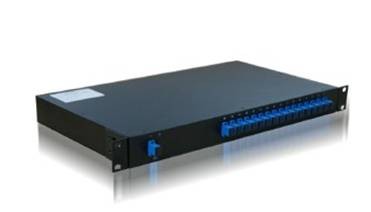波分复用器
CWDM system
Description
Originally, the term "Coarse Wavelength Division Multiplexing" was fairly generic, and meant a number of different things. In general, these things shared the fact that the choice of channel spacings and frequency stability was such that erbium doped fiber amplifiers (EDFAs) could not be utilized. Prior to the relatively recent ITU standardization of the term, one common meaning for Coarse WDM meant two (or possibly more) signals multiplexed onto a single fiber, where one signal was in the 1550 nm band, and the other in the 1310 nm band.
In 2002 the ITU standardized a channel spacing grid for use with CWDM (ITU-T G.694.2), using the wavelengths from 1270 nm through 1610 nm with a channel spacing of 20 nm. (G.694.2 was revised in 2003 to shift the actual channel centers by 1, so that strictly speaking the center wavelengths are 1271 to 1611 nm.) Many CWDM wavelengths below 1470 nm are considered "unusable" on older G.652 specification fibers, due to the increased attenuation in the 1270-1470 nm bands. Newer fibers which conform to the G.652.C and G.652.D standards, such as Corning SMF-28e and Samsung Widepass nearly eliminate the "water peak" attenuation peak and allow for full operation of all twenty ITU CWDM channels in metropolitan networks. For more information on G.652.C and .D compliant fibers please see the links at the bottom of the article.
The Ethernet LX-4 10 Gbit/s physical layer standard is an example of a CWDM system in which four wavelengths near 1310 nm, each carrying a 3.125 gigabit(Gb)-per-second data stream, are used to carry 10 gigabit-per-second of aggregate data.
The main characteristic of the recent ITU CWDM standard is that the signals are not spaced appropriately for amplification by EDFAs. This therefore limits the total CWDM optical span to somewhere near 60 km for a 2.5 Gbit/s signal, which is suitable for use in metropolitan applications. The relaxed optical frequency stabilization requirements allow the associated costs of CWDM to approach those of non-WDM optical components.
CWDM is also being used in cable television networks, where different wavelengths are used for the downstream and upstream signals. In these systems, the wavelengths used are often widely separated, for example the downstream signal might be at 1310 nm while the upstream signal is at 1550 nm.
An interesting and relatively recent development relating Coarse WDM is the creation of GBIC and Small Form Factor Pluggable (SFP) transceivers utilizing standardized CWDM wavelengths. GBIC and SFP optics allow for something very close to a seamless upgrade in even legacy systems that support SFP interfaces. Thus, a legacy switch system can be easily "converted" to allow wavelength multiplexed transport over a fiber simply by judicious choice of transceiver wavelengths, combined with an inexpensive passive optical multiplexing device.
Passive CWDM is an implementation of CWDM that uses no electrical power. Its ability to work is based on the principals of a prism. Many manufactures are promoting passive CWDM to deploy fiber to the home. Used with CWDM SFP transceiver, CWDM XFP transceiver, CWDM X2 transceiver, CWDM SFP+ transceiver

